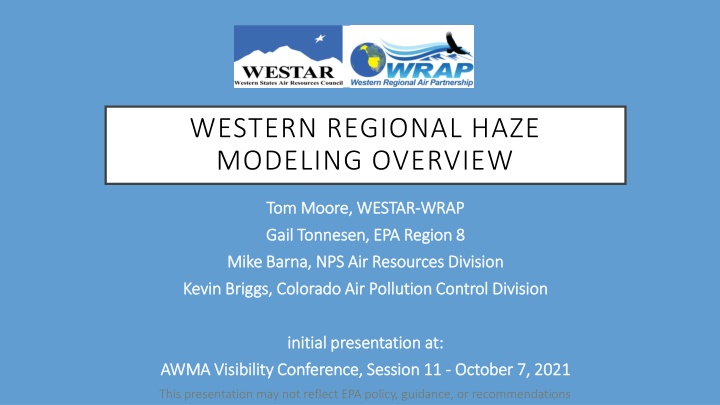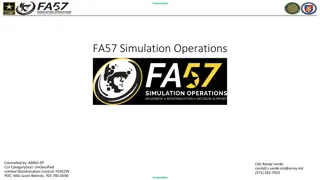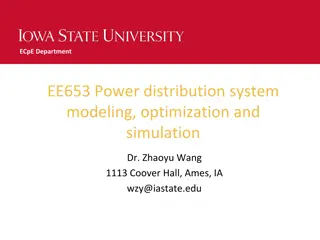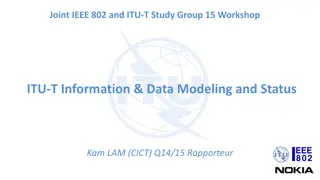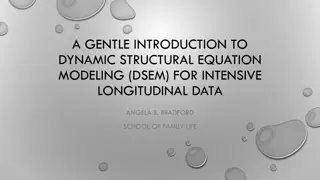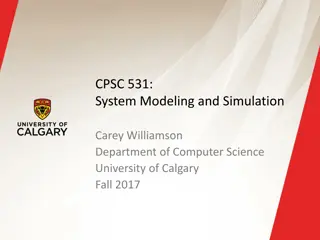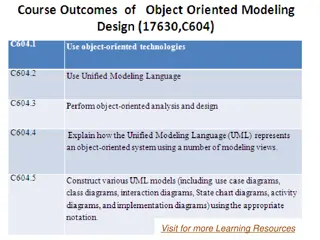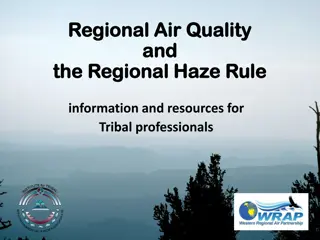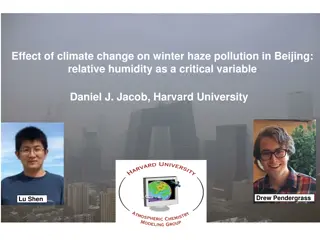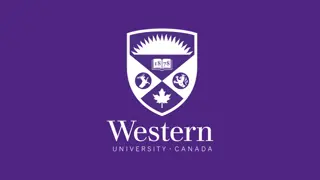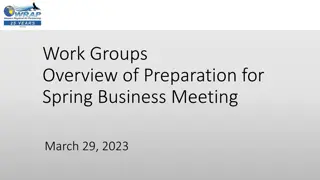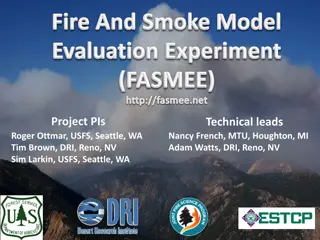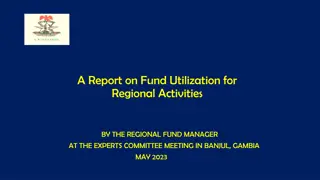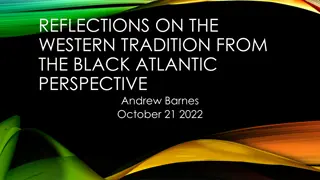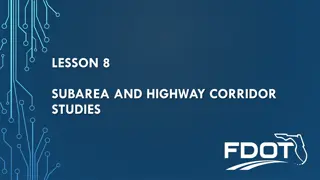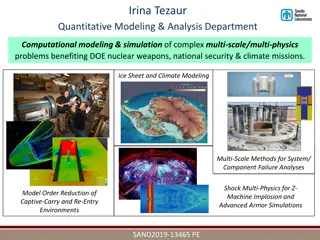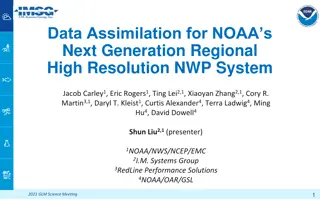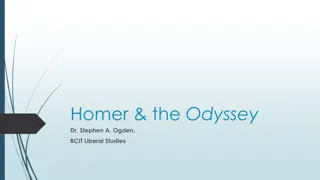Overview of Western Regional Haze Modeling
This presentation provides an overview of Western Regional Haze Modeling, outlining the work plan, division of effort, technical and planning guidance, and applicable documents for regional haze planning. The collaboration and support from various agencies and organizations are acknowledged, emphasizing the structured approach towards achieving air quality goals for ozone, PM2.5, and regional haze. Access to tools and modeling results is available online for further reference and analysis.
Download Presentation

Please find below an Image/Link to download the presentation.
The content on the website is provided AS IS for your information and personal use only. It may not be sold, licensed, or shared on other websites without obtaining consent from the author.If you encounter any issues during the download, it is possible that the publisher has removed the file from their server.
You are allowed to download the files provided on this website for personal or commercial use, subject to the condition that they are used lawfully. All files are the property of their respective owners.
The content on the website is provided AS IS for your information and personal use only. It may not be sold, licensed, or shared on other websites without obtaining consent from the author.
E N D
Presentation Transcript
WESTERN REGIONAL HAZE MODELING OVERVIEW Tom Moore, WESTAR Tom Moore, WESTAR- -WRAP WRAP Gail Tonnesen, EPA Region 8 Gail Tonnesen, EPA Region 8 Mike Barna, NPS Air Resources Division Mike Barna, NPS Air Resources Division Kevin Briggs, Colorado Air Pollution Control Division Kevin Briggs, Colorado Air Pollution Control Division initial presentation at: initial presentation at: AWMA Visibility Conference, Session 11 AWMA Visibility Conference, Session 11 - - October 7, 2021 October 7, 2021 This presentation may not reflect EPA policy, guidance, or recommendations
OUTLINE & ACKNOWLEDGEMENTS OUTLINE & ACKNOWLEDGEMENTS Workplan Technical and Planning guidance Modeling tasks Deliverables: Technical Support System / Intermountain West Data Warehouse Thanks to: the many collaborators WESTAR-WRAP member agencies Board and Technical Steering Committee Work Groups and their Subcommittees Contractor support from ARS, Air Sciences, NAU-ITEP, and Ramboll a special thanks to Pat Brewer! CIRA at Colorado State University
WORKPLAN DIVISION OF EFFORT All tools and modeling results are available at http://views.cira.colostate.edu/tssv2/
GREAT DEAL OF STRUCTURE FOR REGIONAL GREAT DEAL OF STRUCTURE FOR REGIONAL HAZE PLANNING: APPLICABLE TECHNICAL AND PLANNING GUIDANCE DOCUMENTS: APPLICABLE TECHNICAL AND PLANNING GUIDANCE DOCUMENTS: 2017 HAZE PLANNING: 2017- -18 18- -19 19 January 2017 revisions to Regional Haze Rule Emissions Inventory Guidance for Implementation of Ozone and Particulate Matter National Ambient Air Quality Standards (NAAQS) and Regional Haze Regulations (July 2017) WRAP Regional Haze Principles of Engagement (adopted April 4, 2018) WRAP Regional Haze 2018-19 Workplan (April 4, 2018) Modeling Guidance for Demonstrating Attainment of Air Quality Goals for Ozone, PM2.5, and Regional Haze (November 2018 - final version) EPA Technical Guidance on Tracking Visibility Progress for the Second Implementation Period of the Regional Haze Program (December 20, 2018) WRAP Regional Haze 2018-19 Workplan update (April 3, 2019) Guidance on Regional Haze State Implementation Plans for the Second Implementation Period (final August 2019) Communication Framework for Regional Haze Planning (Sept. 3, 2019) Technical Support Document for EPA S Updated 2028 Regional Haze Modeling (Sept. 19, 2019)
(MORE) STRUCTURE FOR REGIONAL (MORE) STRUCTURE FOR REGIONAL HAZE PLANNING: APPLICABLE TECHNICAL AND PLANNING GUIDANCE DOCUMENTS AND WORK PR APPLICABLE TECHNICAL AND PLANNING GUIDANCE DOCUMENTS AND WORK PRODUCTS: HAZE PLANNING: ODUCTS: 2020 2020- -21 21 Work Product / Deliverable Docket Completed Work Products Sources of emissions sector data for WRAP RepBase2 & 2028OTBa2 modeling scenarios (Sept. 2020, final) WESTAR-WRAP region Point Source emissions data used in Regional Haze modeling scenarios o Representative Baseline v2 (RepBase2) and 2028 On The Books v2 (2028OTBa2) (XLS) data review by WESTAR-WRAP region states completed September 18, 2020 o 2028 On The Books v2 (2028OTBa2) and 2028 Potential Additional Controls v2 (PAC2) (XLS) data review by WESTAR-WRAP region states completed October 9, 2020 November 2020 Modeling Scenarios summary table Procedures for Making Visibility Projections and Adjusting Glidepaths using the WRAP-WAQS 2014 Modeling Platform (October 21, 2021, updated final draft) WRAP/WAQS2014/2028 Regional Haze Modeling Run Specification Sheets (August 2021 update, final) WRAP_Emissions_reference_final (Sept. 30, 2021) WRAP_Modeling_reference_final (Sept. 30, 2021)
ANALYSES TO SET UP MODEL: IWDW-WAQS PGM MPE CHECKLIST AND REGIONAL HAZE PLANNING Evaluate monitoring data, planning needs, determine model outputs determine most representative modeling year conduct model performance evaluation select baseline period for planning emissions change projections for 2028 Test and select global model simulations to be used for boundary conditions estimate natural and anthropogenic contributions to boundary conditions Design and specify Representative Baseline (RepBase2) and 2028 On The Books (2028OTBa2) key scenarios for Regional Haze planning
HAZE PLANNING MODELING SCENARIOS AND SUPPORTING ANALYSES Sensitivity simulations for boundary conditions, smoke, and evaluating effects of potential additional controls RepBase2 and 2028OTBa2 CAMx PSAT source appointment modeling Regional evaluations applied to support 2028 visibility projection options State by source sector evaluation for 2028 contribution / consultation support Estimate possible change in visibility by 2028 from baseline period average at 100+ Class I areas Calculate Reasonable Progress Goals per EPA guidance Provide End-Of-Glidepath adjustment options per Sept. 2019 method
END-OF-URP GLIDESLOPE ADJUSTMENTS FOR INTERNATIONAL EMISSIONS AND WILDLAND PRESCRIBED FIRE
ALTERNATIVE WEIGHT-OF-EVIDENCE ANALYSES Dynamic Model Evaluation and U.S. Anthro Emissions Rate-of-Progress analysis to assess Regional Haze without monitoring data adjustment to modeling results U.S. Anthro Rate of Progress Alternative analyses Conducted regional source screening by state: Q/d method to help states identify sources for 4 factor control analyses database and maps of results Q/D Analysis Evaluated potential for emission point source impacts at Class I areas: Weighted Emissions Potential / Area of Influence (WEP/AoI) - WEP maps and data tables of sources and geographic areas with potential to impact each Class I area WEP / AOI Alaska WEP/AOI Hawaii WEP/AOI All monitoring/emissions/modeling/source apportionment/alternate analysis results for Regional Haze planning on TSS and modeling platform available on IWDW
TECHNICAL SUPPORT SYSTEM FOR WESTERN REGIONAL HAZE PLANNING WRAP TSS (colostate.edu) WRAP TSS (colostate.edu) Development of Technical Support System v2 system - data, tools, reference documents Haze analysis Visibility summary base and projection emissions data 2014/rep base/2028 modeling results 2028 source apportionment and sensitivity displays RPG and adjustment graphics Raw data access Necessary since data are needed at each of 118 Class I areas in the WESTAR-WRAP region All in one place, publicly-accessible
ACCESS TO MODELING RESULTS TSS MODELED DATA ANALYSIS - EXPRESS TOOLS
ACCESS TO MODELING RESULTS TSS MODELED DATA ANALYSIS - EXPRESS TOOLS
ACCESS TO MODELING INPUT FILES (in process) IWDW DATA REQUEST
